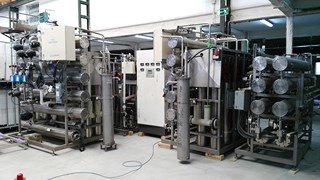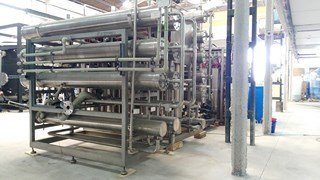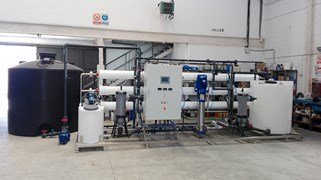Condorchem Envitech Offer
At Condorchem Envitech, we have extensive experience in the design and installation of reverse osmosis equipment for the treatment of wastewater generated in industrial processes.
We have installed reverse osmosis plants for water treatment, either as part of an industrial wastewater treatment process or for obtaining ultrapure water for production processes.
We have an extensive catalog of reverse osmosis membranes, which are classified based on their structure (symmetric or asymmetric), nature (integral or thin-film composite), shape (flat, tubular, or hollow fiber), chemical composition (inorganic or organic), surface (smooth or rough), and operating pressure (very low, low, medium, or high).
Reverse osmosis membranes that operate at very low pressure (5-10 bar) are used to obtain ultrapure water, while those operating at low pressure (10-20 bar) are applied in the removal of nitrates and organic substances from water. Membranes operating at medium pressure (20-40 bar) are required for separation and concentration processes. Finally, desalination of seawater requires a membrane that operates at high pressure (50-80 bar).
We have installed reverse osmosis equipment for the following applications:
- Reverse osmosis is effective in treating wastewater generated by different industries such as the chemical, pharmaceutical, electronics, food and beverage industries, among others. It can remove specific contaminants such as chemicals, heavy metals, inorganic salts, and organic compounds present in these wastewater streams. The semipermeable membrane acts as a barrier for these contaminants, allowing only pure water to pass through.
- Water Reuse: Reverse osmosis allows the treatment of industrial wastewater so that it can be reused in industrial processes or even for agricultural irrigation. By removing contaminants and reducing salt concentration, water treated by reverse osmosis can meet the required standards for reuse.
- Reverse osmosis enables the separation, concentration, and recovery of valuable chemicals present in wastewater. This can result in significant cost savings and reduce the environmental impact of the industry.
- Reverse osmosis is commonly used as a pretreatment stage for other wastewater treatment processes. By removing dissolved solids and reducing the load of contaminants, reverse osmosis can improve the efficiency and extend the life of other treatment systems, such as vacuum evaporation, ultraviolet disinfection, or other membrane processes.
- These systems are highly efficient for desalinating water and producing drinking water from saline water (with salt concentrations ranging from 1,000 to 10,000 mg/L) or seawater (10,000 mg/L of salts). Condorchem Envitech's equipment is capable of operating at pressures sometimes up to 5 times lower than conventional systems (50-70 bar), resulting in a significant reduction in operating costs. These systems can produce drinking water flow rates ranging from 1 to 1,000 m3/day.
- Purification of tap water: Depending on the geographical location, tap water may contain a high content of salts and other substances that, although not harmful, give it unpleasant organoleptic qualities. Condorchem Envitech's tap water purification systems allow the production of water with excellent organoleptic quality. Their innovative modular design allows flow rates of 1-3 L/min for domestic applications and a wide range of higher flow rates for industrial applications (60 L/min to 14,400 L/min).
This article provides a deeper insight into the applications of reverse osmosis.
It is important to note that reverse osmosis membranes become fouled over time as they accumulate operating hours. This necessitates periodic cleaning with chemicals, which will depend on the type of fouling that accumulates. Inorganic precipitated particles accumulate on one hand, while a biofilm forms and feeds on the accumulated particles. This fouling results in reduced membrane efficiency, increased operating pressure, and consequently higher energy costs.
Our reverse osmosis equipment
Advantages
- Obtains high quality water
- Reuses effluent
- Implements a zero discharge strategy for effluents
- Compact and fully automated systems
- For certain applications, it is often the best technology applicable.
Applications
- Food industry
- Pharmaceutical and medical industry.
- Chemical and biotechnology industry.
- Electronic industry.
- Production of water for human consumption.
- Production of irrigation water in agriculture.
- Reuse and zero discharge systems.
Introduction to reverse osmosis
Reverse osmosis is a technology that separates solvent from a concentrated solution by the application of pressure. The solvent passes through a semipermeable membrane from the concentrated solution to the dilute solution. Reverse osmosis leads to two flows: firstly, the practically pure solvent and, secondly, the starting solution made even more concentrated.
Rejected fractions from reverse osmosis membranes can be recovered in the process by simply discharging or by concentrating with other methods, e.g. via evaporation or crystallization plants, to obtain zero discharge.
It is an efficient, clean and compact technology which provides high quality water from brackish water and even sea water. It is also a great ally for the treatment of effluents that have to be reused. Increasingly technologically advanced membranes are being used which allow reasonable permeate flows to be obtained at lower and lower pressures.
Functioning of reverse osmosis
Osmosis is a natural phenomenon that tends to equalize the concentration of two solutions, one concentrated and the other diluted, when these are separated by a semipermeable membrane. To equalize the chemical potential on both sides of the membrane, a solvent flow through the membrane from the diluted solution to the concentrated solution occurs spontaneously. This flow is proportional to the concentration difference and stops when the concentrations are equal.
If a slight pressure is exerted on the more concentrated solution when the osmotic flow occurs through the membrane, the flow is reduced. And if the pressure exerted is increased, there comes a point at which the flow is zero. The exact pressure that stops the flow is the osmotic pressure and depends on the nature of the solute and concentration of the solution. At this point, if the pressure exerted is even greater, the flow is reversed and the solvent flows through the membrane from the concentrated solution to the diluted solution.
It should be noted that the mechanism by which the osmosis occurs is different to the ultrafiltration process, despite the fact that a membrane is used in both cases. Osmosis is based on diffusion of the solvent through the membrane; depending on its type, this means a wide variety of species cannot cross it despite their low molecular weight.
A solvent can be separated from the dissolved solutes with high efficiency by reverse osmosis, obtaining permeates with salt concentrations of the order of 1-5% of the initial concentration.
Semipermeable membranes selectively allow the passage of the solvent while retaining the salts, and are a key component in the process. Initially, they were made of cellulose acetate, but recently polyamide has been shown to be more efficient in controlling pore size and, therefore, permeability.
In general, reverse osmosis membranes are very poorly permeable to ions and electrostatically charged particles, whereas they exhibit very little resistance to the passage of dissolved gases (e.g. oxygen or carbon dioxide) and low molecular weight molecules with no electrostatic charge.
Membrane fouling is an important feature of reverse osmosis, and must be closely controlled as it can pose a threat to productivity. This is due to several causes, such as the precipitation of salts present in the feed, exceeding the solubility product in the concentrate, formation of colloidal sediments and other particles in suspension and the growth of microorganisms on the membrane surface.
The membrane cleaning technique depends on the composition of the feed, the type of membrane and the main cause of the fouling. Generally, membrane rinsing periods consist of alternating between high-speed cleaning solutions being circulated over the membrane surface and periods when the membranes are immersed in cleaning solutions. These are usually:
- To remove precipitates from salts: an acid solution (hydrochloric, phosphoric or citric acid) and chelating agents such as EDTA.
- To remove sediments and organic compounds: alkaline solutions combined with surfactants.
- To remove microorganisms: chloride and chloride derivative solutions that sterilize the membranes.
A good membrane cleaning programme lengthens its useful life and, in most cases, a feed pre-treatment process is desirable; this is often recommended to be filtration followed by ultrafiltration.



